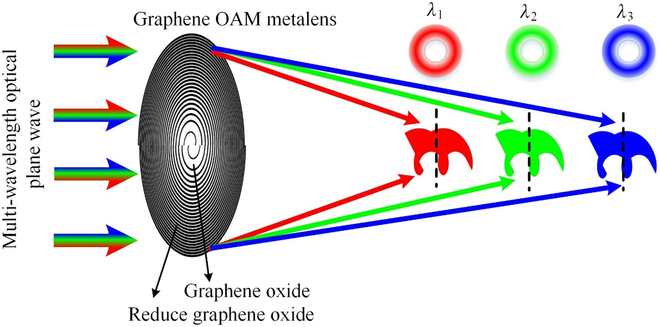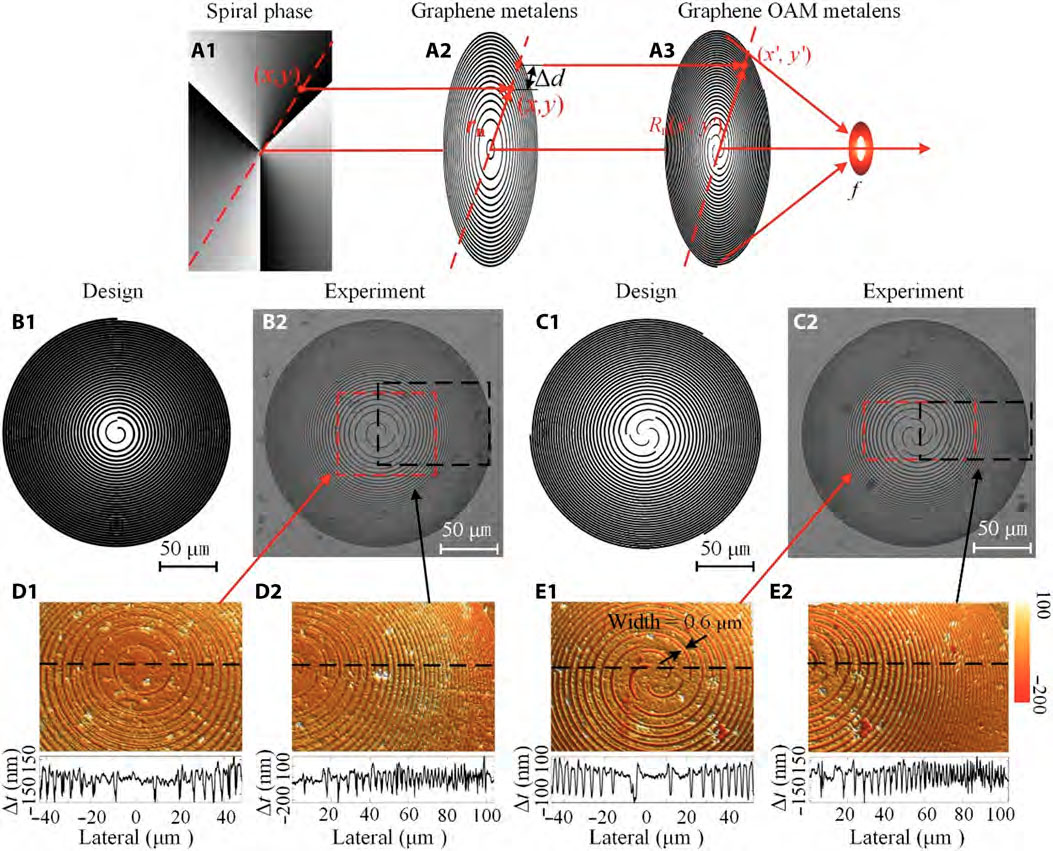| Oct 12, 2023 | |
Graphene lenses focus light into spirals and doughnuts |
|
| (Nanowerk Spotlight) Conventional lenses made of glass can only focus light in a limited way, restricting many potential applications in optics and photonics. Now researchers have developed a new type of lens made from atom-thin graphene that can focus light into complex patterns, opening possibilities for advanced technologies. | |
| The new graphene metalenses outlined in a paper published in Ultrafast Science ("Broadband Diffractive Graphene Orbital Angular Momentum Metalens by Laser Nanoprinting") rely on the unique way graphene interacts with light. By carefully tuning graphene's optical properties, researchers can make lenses that shape light beams into intricate shapes beyond what regular lenses can achieve. | |
 |
|
| Conceptual design of a broadband graphene OAM metalens that focuses different wavelengths at different positions with desired topological charges. (© Ultrafast Science) | |
| “Graphene provides new degrees of freedom to manipulate light,” said Dr. Han Lin, an author of the paper from RMIT University in Australia. “With clever engineering, we can design graphene lenses to focus light into doughnut and spiral shapes, which is not possible using normal lenses.” | |
| These exotic light patterns, containing orbital angular momentum, could enable advances in areas like optical trapping, quantum communication, microscopes and data storage. But typically, special bulky equipment is needed to generate them. | |
| The new graphene metalenses proposed by the RMIT team provide a route to miniaturize this capability. At just 200 nanometers thick, the lenses are millions of times thinner than a human hair. This makes them prime candidates to generate orbital angular momentum light beams within integrated photonic chips. | |
| “Our ultracompact graphene lenses unlock abilities inaccessible to conventional glass optics,” said Dr. Lin. “This opens new horizons for controlling light at the nanoscale.” | |
| The design process relies on graphene’s ability to alter both the amplitude and phase of light passing through it. By carefully tuning graphene’s optical properties, the researchers can create lenses that impart precise wavefront shaping effects. | |
| “Graphene allows us to simultaneously control amplitude and phase, which provides tremendous design flexibility compared to normal materials that can only affect one or the other,” said Dr. Lin. | |
 |
|
| Schematics of a graphene orbital angular momentum (OAM) metalens combining a graphene metalens with the spiral phase of a topological charge l = 3 based on the detour phase method. (a1) Spiral phase with l = 3. (a2) Schematic of a graphene metalens. (a3) Schematic of a graphene OAM metalens. Structure design (b1) and microscopic image (b2) of a fabricated graphene OAM metalens with a topological charge of 1. Structure design (c1) and microscopic image (c2) of a fabricated graphene OAM metalens with a topological charge of 3. (d1 and d2) Optical profiler images of the fabricated graphene OAM metalens in b2 in the red and black rectangles and cross-sectional plots marked by the black dashed lines. (e1 and e2) Optical profiler images of the graphene OAM metalens in c2 in the red and black rectangles and cross-sectional plots marked by the black dashed lines. (© Ultrafast Science) | |
| Using analytical equations and principles from holography, the researchers devised a technique to design graphene lenses that can focus light into patterns carrying orbital angular momentum. This includes donut and spiral shapes, where the phase of the light beam winds around the central axis. | |
| Importantly, the graphene metalenses can focus light from across the visible spectrum, from blue to red. This broadband capability arises because graphene interacts with light in a very consistent way across wavelengths. | |
| “The achromatic performance means the designed light patterns maintain their form over a wide bandwidth,” said Dr. Lin. “This cannot be achieved using metasurfaces made from conventional optical materials.” | |
| To fabricate the designed metalenses, the researchers used a technique called laser nanoprinting to carefully alter the structure of graphene. This relies on an ultrafast femtosecond laser, which modifies graphene in a highly confined manner without damaging the surrounding material. | |
| “Our laser nanoprinting approach enables fast, scalable and accurate fabrication of the designed graphene patterns,” said Dr. Lin. | |
| The researchers printed two different metalenses: one producing a spiral phase with a topological charge of 1, and the other with a charge of 3. They tested the graphene lenses at wavelengths from 450 to 750 nanometers and showed they could produce the desired spiral light patterns over the whole visible range. | |
| “The experimental results closely matched our theoretical designs, demonstrating the power of our method,” said Dr. Lin. “Just by changing the topological charge values, many different metalenses producing exotic structured light can be designed.” | |
| Because orbital angular momentum is an extra degree of freedom, it can multiplex more information channels onto a light beam. The graphene metalenses could therefore boost the bandwidth of optical communications. | |
| The doughnut shape of the focused light beam also has advantages for optical trapping and manipulation. The darkness at the center enables strong gradient forces for trapping particles smaller than the beam diameter. | |
| “The broadband graphene metalenses open up new possibilities for structured light generation in an integrated platform,” concluded Dr. Lin. “We expect them to enable innovations in areas like optical trapping, quantum optics, microscopy and sensing.” | |
| With further development of the technique, the researchers envision creating optimized graphene metalenses for specific applications across photonics, optics and microscopy. | |
 By
Michael
Berger
– Michael is author of three books by the Royal Society of Chemistry:
Nano-Society: Pushing the Boundaries of Technology,
Nanotechnology: The Future is Tiny, and
Nanoengineering: The Skills and Tools Making Technology Invisible
Copyright ©
Nanowerk LLC
By
Michael
Berger
– Michael is author of three books by the Royal Society of Chemistry:
Nano-Society: Pushing the Boundaries of Technology,
Nanotechnology: The Future is Tiny, and
Nanoengineering: The Skills and Tools Making Technology Invisible
Copyright ©
Nanowerk LLC
|
|
|
Become a Spotlight guest author! Join our large and growing group of guest contributors. Have you just published a scientific paper or have other exciting developments to share with the nanotechnology community? Here is how to publish on nanowerk.com. |
|
